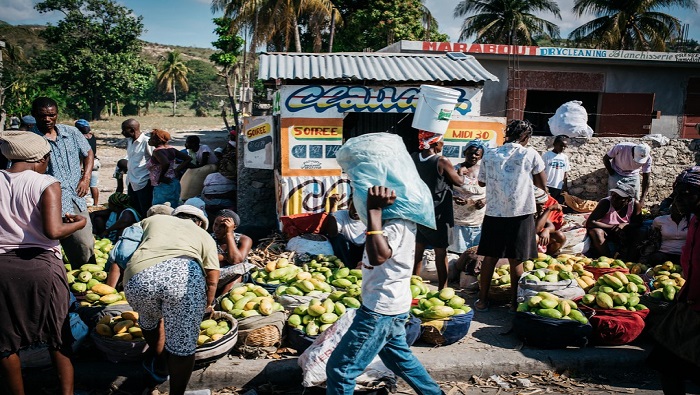60% of the Caribbean country’s population now lives in poverty, and experts are calling for strengthening the local currency and raising tariffs to favor local agriculture. Meanwhile, the island nation is mired in yet another grave institutional crisis.
Playing the victim-of-colonial-exploitation card to explain the lack of development in the present never goes down well, especially among the old colonial powers, but history that involves a disproportionate debt that began in the 19th century and continued until 1947 is more difficult to ignore. Haiti has things in common with its neighboring countries: an economic structure based on cheap labor — the export of textiles is the second source of foreign currency, after remittances — and Washington’s interference.
The United States invaded and occupied the country between 1915 and 1934, and then pampered dictators whose main virtue was staunch anti-communism. These included François Duvalier and his son Jean Claude, who between 1957 and 1986 ruled Haiti with an iron fist.
But the country also presents notable differences. It was the first country in the Americas to abolish slavery upon independence from France in 1804. And it was, in turn, the most severely punished for its audacity two decades later. A French army led by Baron Mackau forced the Haitian government into a ruinous agreement in which France would accept 150 million francs as compensation to former colonizers for the expropriation of lands and slaves.
With a size that was equivalent to 10 times the new country’s budget, the compensation forced it to take on a debt with French banks that was transformed over and again until it ended up among the assets of the American National City Bank, the predecessor of Citibank.
Unlike the debt with which other countries improve their productive structure by building hospitals, schools, and roads, the repayments that Haiti had to make until the middle of the 20th century addressed a much more basic concept, which was the right to exist as a nation. Research published by The New York Times in 2022 estimated what would have to be paid to Haiti to repair the damage, and it amounted to between $21,000 million and $115,000 million dollars in today’s money. “1.5 and 8 times the size of Haiti’s economy in 2020,” the American newspaper estimated.
According to MIT historian Malick Ghachem, this debt also generated a fundamental obstacle to the country’s development that has not yet been resolved: the use of the dollar as the reference currency. The country’s current central bank, he explains, is the heir of a National Bank of Haiti that was created to ensure payment to French financial interests first, and to American interests afterwards.
“The gourde is the official currency, but Haiti has never had a monetary authority with the freedom and capacity to make policies that put the needs of the citizens first,” says Ghachem, author of the book The Old Regime and the Haitian Revolution.
Since remittances are transformed into gourdes before reaching ordinary Haitians, the dollar is the almost exclusive preserve of Haitian banks, businesses, and millionaires. As demonstrated by the experiences of Argentina, Venezuela, and Lebanon, which in other ways have also ended up with the dollar as a reference currency, the consequences for the economy are disastrous: devaluation-inflation cycles that feed off each other, and very low purchasing power among the population.
In Haiti, the price of the dollar has multiplied by three in just ten years, with inflation registering levels of 20% in January, according to the estimates by Kesner Pharel, who is head of the consultancy Groupe Croissance in Port au Prince. But can the gourde achieve stability and gain purchasing power? Ghachem recognizes that the solution he proposes is not easy. It would mean that the central banks of the Eurozone and the United States contribute to stabilizing the gourde with interventions in the exchange market within a broader policy that would include tariff relief and other incentives for Haitian exports so that the strengthened currency does not worsen the balance of payments.
“I’m not saying that it will be easy, or even that strengthening the currency is going to be the magic solution to return Haiti to democracy, what I am saying is that if we don’t pay attention to that, the other security measures are not going to work,” Ghachem says. “If this crisis is not serious enough to convince the international community of the need for far-reaching measures to end the legacy of slavery and colonization, I don’t know what crisis will,” he adds, referring to the political chaos that Haiti is experiencing. The situation in the country has worsened after the resignation in March of the acting president Ariel Henry, who acquiesced to a demand by the armed gangs that have taken over a large part of the country.
According to Jake Johnston, a researcher in Washington at the CEPR think tank, an equally fundamental problem for the economy is the fact that the state itself is virtually nonexistent for “a very large majority of the population that lives without services or state protection.” Up to 80% of the public services that the government should provide are managed by non-governmental entities from outside the country, he says.
The presence of NGOs from rich countries has only increased since the 2010 earthquake that claimed between 92,000 and 300,000 lives (the lack of a precise number is another indicator of institutional weakness). It is a phenomenon that, according to Johnston, has to do with a lack of trust in local organizations and an institutionalized model of development aid that seeks to reward companies and organizations from donor countries. According to Johnston, United Nations interventions such as those from 1993-2001 and those from 2004-2017 ultimately fail because the presence of soldiers covers up the need to fix the Haitian institutions themselves “and the problems resurface as soon as they leave.”
Corruption
Johnston, who in January published the book Aid State on the effects of foreign intervention in Haiti, believes that the international community can do several things to improve Haiti’s chances. They need to stop directing aid towards their own NGOs and companies, strengthen local institutions, and demand transparency from them, but also report cases of corruption to them when they occur, “instead of covering them up to gain leverage over those who are involved in wrongdoing.” They should also bring to light the wealth that the Haitian ruling class hides in rich countries, and study mechanisms to channel the historic debt of $21 billion into development tools.
According to University of Virginia professor and Haiti expert Robert Fatton, a basic economic measure to fight poverty — which affects more than 60% of the population, according to Pharel’s estimates — is to reduce dependence on imported food by gradually raising the tariffs that Haiti abruptly dropped in the 1990s (from 50% to 3%), which ruined the cultivation of rice, a basic staple in the country.
A classic obstacle to such a measure is the power exercised by the people who made money from the import business and may be harmed by the gradual reimposition of tariffs. Like other prominent groups in the country, they have direct ties to armed gangs. But according to Fatton, that’s something that could be changing. “The gangs have begun to gain a certain autonomy, and they no longer work so much under the orders from outsiders,” he says. “Right now the only businessmen who are happy with the situation are those who deal in drugs, money laundering, and handgun trafficking.” (https://english.elpais.com/international/2024-04-03/haiti-an-economy-condemned-by-a-19th-century-debt.html)



































